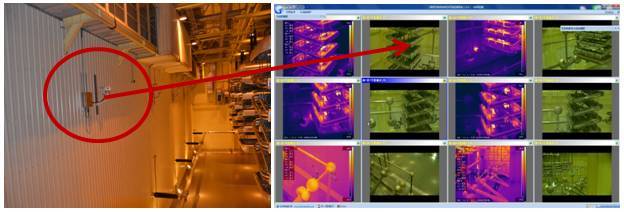Working principle
Natural light is composed of light waves with different wavelengths. The range visible to human eye is 390-780nm. The electromagnetic waves shorter than 390nm and longer than 780nm can’t be felt by the human eyes. Among them, electromagnetic waves with a wavelength less than 390nm are outside the violet of the visible light spectrum and are called ultraviolet rays; electromagnetic waves longer than 780nm are outside the red of the visible light spectrum and are called infrared, and their wavelength ranges from 780nm to 1mm.
Infrared is an electromagnetic wave with a wavelength between microwaves and visible light, and has the same essence as radio waves and visible light. In nature, all objects whose temperature is higher than absolute zero (-273.15°C) continuously radiate infrared rays. This phenomenon is called thermal radiation. Infrared thermal imaging technology uses micro thermal radiation detector, optical imaging objective and opto-mechanical scanning system to receive the infrared radiation signals of the object to be measured, and the focused infrared radiation energy distribution pattern is reflected to the photosensitive element of the infrared detector after spectral filtering and spatial filtering, that is, the infrared thermal image of the measured object is scanned and focused on the unit or spectroscopic detector, the infrared radiant energy is converted by the detector into electrical signal, which is amplified and converted into standard video signal, and displayed as infrared thermal image on TV screen or monitor.

Infrared is an electromagnetic wave with the same essence as radio waves and visible light. The discovery of infrared is a leap in human understanding of nature. The technology that uses a special electronic device to convert the temperature distribution on the surface of an object into an image visible to the human eye and displays the temperature distribution on the surface of the object in different colors is called infrared thermal imaging technology. This electronic device is called an infrared thermal imager.
Infrared thermal imager uses infrared detector, optical imaging objective and opto-mechanical scanning system (the current advanced focal plane technology eliminates the opto-mechanical scanning system) to receive the infrared radiation energy distribution pattern of the object to be measured and reflect it to the photosensitive element of the infrared detector. Between the optical system and the infrared detector, there is an optical-mechanical scanning mechanism (the focal plane thermal imager does not have this mechanism) to scan the infrared thermal image of the object to be measured and focus it on the unit or spectroscopic detector. The infrared radiant energy is converted into electrical signals by the detector, and the infrared thermal image is displayed on the TV screen or monitor after amplification and conversion to standard video signal.
This kind of thermal image corresponds to the thermal distribution field on the surface of the object; in essence, it is the thermal image distribution diagram of the infrared radiation of each part of the object to be measured. Because the signal is very weak, compared with the visible light image, it lacks gradation and third dimension. In order to judge the infrared heat distribution field of the object to be measured more effectively in the actual action process, some auxiliary measures are often used to increase the practical functions of the instrument, such as the control of image brightness and contrast, real standard correction, false color drawing contour and histogram for mathematical operations, printing, etc.
Thermal imaging cameras are promising in the emergency industry
Compared with traditional visible light cameras that rely on natural or ambient light for camera monitoring, thermal imaging cameras do not require any light, and can clearly image relying on the infrared heat radiated by the object itself. The thermal imaging camera is suitable for any lighting environment and is not affected by strong light. It can clearly detect and find targets, and identify camouflaged and concealed targets regardless of day or night. Therefore, it can truly realize 24-hour monitoring.
Post time: May-28-2021





